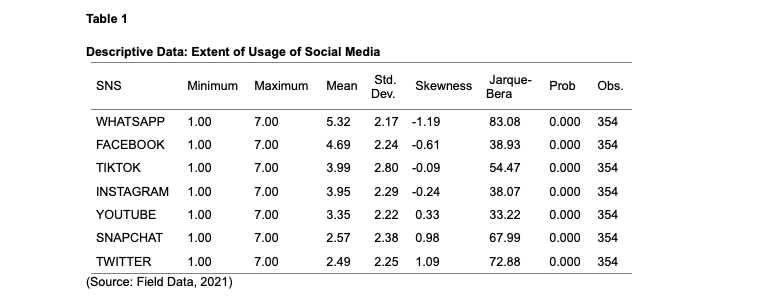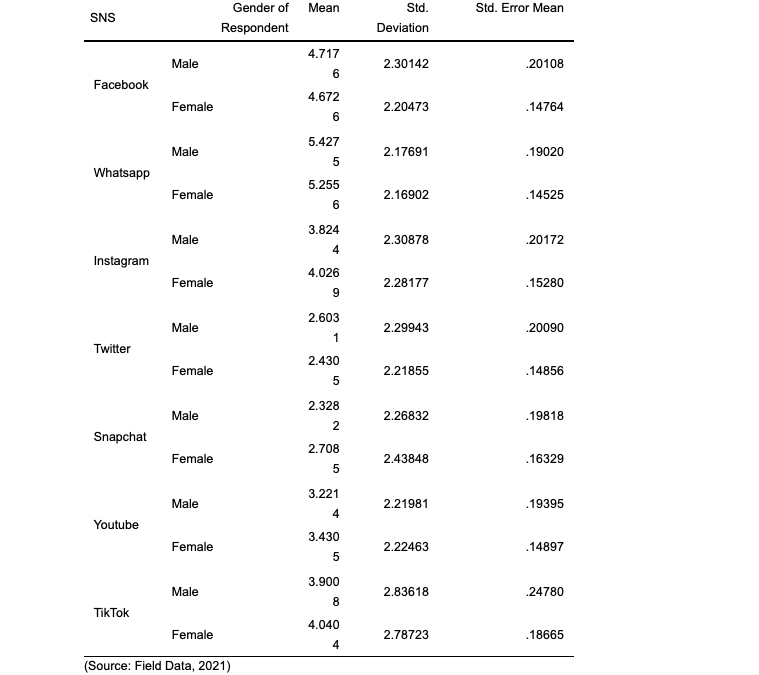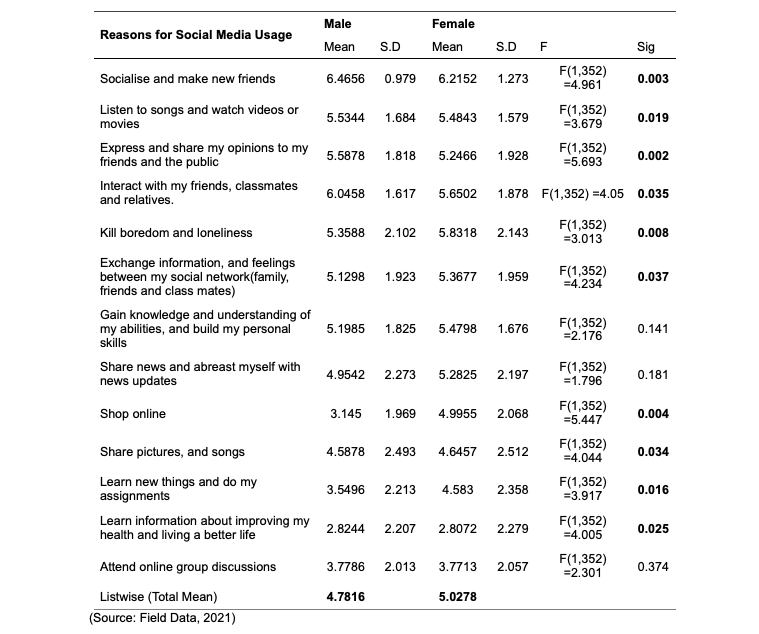
Social Media Adoption among Students – The Role of Gender
Gender has been found to have a significant impact on why people accept new technologies. Despite the critical role of gender in social media adoption, no such studies have been undertaken among Ghanaian senior high school students. This research aimed to address this gap by analyzing students’ perspectives on gender concerning social media adoption. The analysis was conducted using the mean scores, standard deviation, and ANOVA. The study established that gender affects social media adoption, as substantial variations in the perceived need for adoption were discovered between male and female students.
Introduction
The rapid advancement of social media technology has a significant impact on how people interact regularly. Research has shown that there are 4.48 billion social media users worldwide as of July 2021, accounting for about 57% of the global population (Data Reportal, 2021). These statistics explain that more than nine in ten internet users currently use social media monthly. The growing trend of social media use among today’s youth cannot be overstated or ignored (Owusu-Acheaw & Larson, 2015). More specifically, social networking among students has grown in recognition over the years (Markwei & Appiah, 2016). Previous studies indicate that between 67% and 75% of students use social media, and another survey discovered that 90% of students use Facebook (Alahmar, 2016). A social networking site is an essential tool for interacting with people on campus and with relatives from other locations. However, social media use in recent decades is mainly due to the ease of accessibility to internet-connected devices such as tablets, cellphones, laptops, iPads, and Apple mobile phones (Garca-domingo et al. 2017; Owusu-Acheaw & Larson, 2015; Otu, 2015). As a result, social media addiction has skyrocketed recently (Mamak, Ehram & Mohsen, 2018).
Numerous studies have been undertaken to determine the extent to which students use social media applications (Al-Qaysi, Mohamad-Nordin, Al-Emran, & AlSharafi, 2019). Gender has been discovered to play a significant role in explaining why people adopt modern technologies (Efosa, Mahesh, Ogechi & Nubi, 2017; Othman, Al-Rahmi, & Mi Yusuf, 2015). A few studies on gender differences in social media user behavior discovered that males used social media platforms to meet new friends, network, look for partners, and play computer games. In contrast, females used them for maintaining their relationships (Psylla, Sapiezynski, Mones, & Lehmann, 2017) and public message posting (Kircaburun, Alhabash, Tosuntaş, & Griffiths, 2020). Another study found that females utilized social networking sites primarily to reconnect with old acquaintances and maintain contact with old ones while concealing their personalities and private details for privacy reasons (Alhabash & Ma, 2017). Horzum (2016) indicated that men are motivated more by contributory variables such as perceived usefulness, whereas social and process factors drive women. Similar conclusions were found in a study conducted in Turkey involving 220 female and male university students. The study discovered that social networking sites had a detrimental effect on students’ studies and habits (Gok, 2015). Gok (2015) also examined gender differences in social networking site usage. The results revealed that among the numerous students (males and females) active in social networking, some developed an addiction, which had a detrimental effect on their academic performance, habits, and social lives. Much research conducted worldwide revealed considerable gender differences in university students’ social media usage (Alnjadat, Hmaidi, Samha, Kilani, & Hasswan, 2019). Some other studies examine the effect of gender and personality characteristics on an individual’s use of social media (Alkaabi, Albion, & Redmond, 2017; Bouton & Asterhan, 2017). They discovered that females are more likely to utilize social media for educational interests than males. Despite the indispensable role of gender in the adoption of social media, no such studies have been conducted among senior high school students in Ghana. The study seeks to address this research gap by examining students’ perceptions to understand the role of gender in social media adoption.
Methodology
The descriptive survey approach was utilized in this study because it was treated as one of the most successful strategies for collecting data in a short period while conserving money and time (Callan & Margaret, 2020). A Likert scale questionnaire with closed-ended questions was developed (García-Domingo et al., 2017). The closed-ended questions were employed to ascertain respondents’ social media adoption patterns. The Likert scale included seven levels, ranging from “Strongly Disagree” to “Strongly Agree.” The questionnaires were distributed face-to-face to 354 students aged 15 to 24 years in the Ledzokuku Municipal District. Both females and males completed the same questionnaires. The mean scores, standard deviation, and ANOVA were used for the analysis. The Statistical Package for the Social Sciences (SPSS) version 23 was used for data entry and analysis.

Findings
The respondents (both male and female) were asked to explain the extent to which students habitually use the different social media networks (see Table 1). The descriptive statistics comprises minimum, maximum, mean, standard deviation, skewness, Jarque-Bera, and Probabilities. Responses ranged from a minimum of 1 to a maximum of 7.
The extent of Usage of Social Media

The study discovered that WhatsApp is extensively adopted by students (mean =5.32, SD=2.17), after that Facebook (mean=4.69, SD=2.24), Tktok (mean=3.99, SD=2.80), Instagram (mean=3.95, SD=2.29), Youtube (mean=3.35, SD=2.22), Snapchat (mean=2.57, SD=2.38), and Twitter (mean=2.49, SD=2.25). This shows that most students access WhatsApp more than the other revealed social networks.
Gender and Extent of Usage of Social Media
It is discovered that male students used Facebook (Meanmale= 4.7176, MeanFemale= 4.6726), WhatsApp (Meanmale= 5.4275, MeanFemale= 5.2556), Twitter (Meanmale= 2.6031, MeanFemale= 2.4305), more than the female students. On the other hand, it was discovered that the female students used more of Instagram (Meanmale= 3.8244, MeanFemale= 4.0269), snapchat (Meanmale= 2.3282, MeanFemale= 2.7085), Youtube (Meanmale= 3.2214, MeanFemale= 3.9008), and Tiktok (Meanmale= 3.9008, MeanFemale= 4.0404) (Table 2).
Table 2 Gender and Extent of Social Media Usage

Perceived Needs and Adoption of Social Media
This section examined whether the perceived needs of the students influence the adoption of social media among the students. An ANOVA was performed to determine the role of gender in the adoption of social media. It was discovered that gender plays a significant role in the perceived needs which influence students to adopt social media. Significant differences were found for all the variables (p-value less than 0.05), except three variables with p-values greater than 0.05 (Gain knowledge and understanding of my abilities and build my personal skills where the p-value is 0.141; Share news and abreast myself with news updates p-value is 0.181; Attend online group discussions with p-value 0.374) (Table 3). Overall, the variables showed significant differences in social media adoption. The comparison of the mean differences of the significant variables showed further that Male students are attracted to social media for Socialisation and making new friends (Meanmale= 6.4656, MeanFemale= 6.2152), Listening to songs, and watching videos or movies (Meanmale= 5.5344, MeanFemale= 5.4843), Expressing and sharing my opinions to my friends and the public (Meanmale= 5.5878, MeanFemale= 5.2466), and, Interacting with my friends, classmates, and relatives (Meanmale= 6.0458, MeanFemale= 5.6502).
On the other hand, Female students are enticed to adopt social media to kill boredom and loneliness (Meanmale 5.3588 < MeanFemale 5.8318), Exchange information and feelings between my social network (Meanmale 5.1298 < MeanFemale 5.3677), Shop online (Meanmale 3.145 < MeanFemale 4.9955), Share pictures, and songs (Meanmale 4.5878 < MeanFemale 4.6457), Learn new things and do my assignments (Meanmale 3.5496 < MeanFemale 4.583), and Learn information about improving my health and living a better life (Meanmale 2.8244 < MeanFemale 2.8072). Despite the significant differences (p-values less than 0.05), it was discovered both genders less adopt social media to Learn information about improving their health and living a better life (mean values less than 4 for both genders). However, the overall mean for all the variables showed that female students have adopted social media more than male students.
Table 3 Means and F values scores

Discussion
The study showed that most students spend more time on Whatsapp as compared to the other mentioned social networks. This is following the fact that WhatsApp is the most widely adopted app in Ghana, according to Statista (2021). Factually, Otu (2015) investigated social media behaviors among students and concluded that the majority of youngsters were addicted to social media (especially WhatsApp). Similarly, Othman et al. (2015) found that 90.5 percent of students at College utilize at least one social networking site, with Whatsapp and Facebook being the most prevalent. Our result also corroborates the notion that, according to Statista (2021), Facebook has become the most popular social media with roughly 2.8 billion monthly active users.
Male students use more of Facebook, WhatsApp, and Twitter than female students. The female students as well use Snapchat, Instagram, Tiktok, and YouTube at a higher rate than male students do. Gender affects social media adoption, as the study showed significant differences in the perceived need for adoption between male and female students. Our findings corroborate previous research indicating statistically significant differences in social networking adoption between genders (Horzum 2016; Garca-domingo et al. 2017; Gwena et al. 2018; Krasnova et al. 2017). The study discovered that female students are more likely to use social media to meet perceived needs than male students. This is consistent with earlier results showing female users of social media outnumber male users (Garca-domingo et al. 2017; Lin, Featherman, & Sarker 2017). Female using social media more often is also confirmed by recent studies by Bouton and Asterhan (2017), which found that female students frequently utilize social media to post more material than males. Additionally, it is well-known that the gender construct has been used as a moderator in research on social media adoption (Krasnova et al., 2017; Lin et al. 2017). Krasnova et al. (2017) also examined gender differences in social media usage. The data indicated that there is a gender disparity in young students’ social media adoption. Males, on the other hand, use social media more for amusement purposes, while women use it for communication and information purposes.
There is a distinct difference in how both genders use social media. Males are solely adopted for making new contacts, whereas women are found to use them to kill boredom and loneliness as well as for informative purposes (Mazman & Usluel, 2011). On the contrary, a survey of students in Australia by Yazdanpanah & Forouzani (2015) on Arabians discovered that female users are less likely to adopt social media due to negative perceptions about the content for religious reasons.
This current study has contributed to the literature by identifying the gender differential adoption of social media among students in second-cycle schools. However, it was limited by the sample size focused on three schools in the Ledzokuku Municipal District in Accra, which might affect the research generalizability. It is recommended that future studies be carried out across different districts in Ghana to understand the implications of cross-culture on the role of gender in the adoption of social media.
Author: Mercy Aku Asante
Bibliography (standard format of citations according to international standards):
References
Alahmar, T. (2016). The impact of social media on the academic performance of the second-year medical students at College of Medicine, University of Babylon, Iraq. J Med Allied Sci 2016; 6(2):77-83 DOI: 10.5455/jmas.236927
Alhabash S, Park H, Kononova A, Chiang YH & Wise K. (2012). Exploring the motivations of Facebook use in Taiwan. Cyberpsychology, Behavior, and Social Networking, 15(6), 304- 311.
Alkaabi, S. A., Albion, P., & Redmond, P. (2017). Social network misuse in the classroom and its impact on male student motivation in UAE tertiary education. IAFOR Journal of Education, 5(SI), 115-131.doi:10.22492/ije.5si.05
Alnjadat, R., Hmaidi, M. M., Samha, T. E., Kilani, M. M., & Hasswan, A. M. (2019). Gender variations in social media usage and academic performance among the students of the University of Sharjah. Journal of Taibah University Medical Sciences, 14(4), 390–394. https://doi.org/10.1016/j.jtumed.2019.05.002
Al-Qaysi, N., Mohamad-Nordin, N., & Al-Emran, M. (2019). An Empirical Investigation of Students’ Attitudes Towards the Use of Social Media in Omani Higher Education. In International Conference on Advanced Intelligent Systems and Informatics (pp. 350–359). Springer.
Bouton, E. & Asterhan, C. S.C., (2017). Teenage peer-to-peer knowledge sharing through social network sites in secondary schools. Computers & Education, 110, 16–34. https://doi.org/10.1016/j.compedu.2017.03.007
Callan, J. & Margaret A. (2020). Influences upon social media adoption and changes to training delivery in vocational education institutions, Journal of Vocational Education & Training, DOI: 10.1080/13636820.2020.1821754
Data Reportal (2021) Social Media Users Worldwide.[Blog] Retrieved at https://datareportal.com/social-media-users
Efosa C., Mahesh S., Ogechi A & Nubi A (2017). The Effects of Gender on the Adoption of
Social Media: An Empirical Investigation. Twenty-third Americas Conference on Information Systems, Boston.
García-Domingo, M., Aranda, M. & Fuentes, V.M., (2017) Facebook use in university students: Exposure and reinforcement search’, Procedia – Social and Behavioral Sciences 237, 249–254. https://doi.org/10.1016/j.sbspro.2017.02.071
Gok, T. (2015). The positive and negative effects of digital technologies on students’ learning. In Sahin, I., Kiray, A., & Alan, S. (Eds.), Proceeding Book of International Conference on Education in Mathematics, Science & Technology (ICEMST), 215-219, Antalya.
Horzum, M. B. (2016). Examining the relationship to gender and personality on the purpose of Facebook usage of Turkish university students. Computers in Human Behavior, 64, 319–328.
Kircaburun, K., Alhabash, S., Tosuntaş, Ş.B. & Griffiths (2020) Uses and Gratifications of Problematic Social Media Use Among University Students: a Simultaneous Examination of the Big Five of Personality Traits, Social Media Platforms, and Social Media Use Motives. International Journal of Mental Health Addiction 18, 525–547 (2020). https://doi.org/10.1007/s11469-018-9940-6
Krasnova, H., Veltri, N. & Eling, N. & Buxmann, P. (2017). Why Men and Women Continue to Use Social Networking Sites: The Role of Gender Differences. The Journal of Strategic Information Systems. 26. 10.1016/j.jsis.2017.01.004.
Lin, H., Swarna, H., Bruning, P. (2017). Taking a global view on brand post popularity: Six social media brand post practices for global markets. Business Horizons. 60. 621-633. 10.1016/j.bushor.2017.05.006.
Mamak D., Ehram S. & Mohsen G. (2018)Proposing a Model for Analysing Impact of Social Media on Academic Performance of Students: A Case Study of Allameh Tabatabai University. Journal Of Soft Computing And Decision Support Systems. 5(2),10-14
Markwei, D. & Doreen A.(2016). The Impact of Social Media on Ghanaian Youth: A Case Study of the Nima and Maamobi Communities in Accra, Ghana. Journal of Research on Libraries & Young Adults n. page.
Othman, M.,Al-Rahmi, W. & Mi Yusuf, L. (2015). The Role of Social Media for Collaborative Learning to Improve Academic Performance of Students and Researchers in Malaysian Higher Education. The International Review of Research in Open and Distributed Learning. 16. 177-204. 10.19173/irrodl.v16i4.2326.
Owusu-Acheaw1 and Agatha Gifty Larson (2015) Use of Social Media and its Impact on Academic Performance of Tertiary Institution Students: A Study of Students of Koforidua Polytechnic, Ghana. Journal of Education and Practice 6 (6).
Psylla I., Sapiezynski P, Mones E, & Lehmann S (2017). The role of gender in social network organization. PLoS ONE 12(12): e0189873. https://doi.org/10.1371/journal.
pone.0189873



